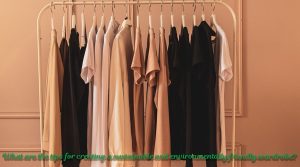
What are the do's and don'ts of dressing for professional settings
What are the do’s and don’ts of dressing for professional settings?
Introduction
The way you dress can make a big impact on your success in a professional setting. It is important to understand what is considered appropriate attire in such environments, as dressing inappropriately can be detrimental to your image and career. In this post, we’ll explore the do’s and don’ts of dressing for professional settings so that you can always make a great first impression.
Do’s of Dressing for Professional Settings
Choose appropriate attire for the occasion
One of the most important things to consider when dressing for professional settings is the type of attire that is appropriate for the occasion. There are typically two categories of professional dress: business casual and business formal. Understanding the difference between the two is key to dressing appropriately. For example, business casual attire typically includes slacks and a collared shirt for men, and skirts or dresses with a hemline below the knee for women. On the other hand, business formal attire for men typically includes a suit and tie, and for women, a dress or suit.
It’s also important to consider any industry-specific dress codes. For example, in the legal or finance industries, business formal attire is often the standard. On the other hand, in tech or creative industries,business casual attire may be more acceptable.
Dress for your body type
Another important factor to consider when dressing for professional settings is finding clothing that fits your body type well. Clothes that fit properly can help you feel confident and comfortable, while clothes that are too loose or too tight can make you feel self-conscious. When shopping for
, pay attention to the fit of the garments and choose pieces that flatter your body shape.
In addition to finding the right fit, it’s also important to enhance your best features through your clothing choices. For example, if you have great legs, you might choose a skirt or dress that shows them off. If you have a nice neckline, you might choose a blouse with a flattering neckline.
Focus on grooming and hygiene
Finally, it’s important to focus on grooming and hygiene when dressing for professional settings. This means making sure that your hair is clean and well-groomed, and that your breath is fresh. Additionally, make sure that your clothes are clean and free of wrinkles or stains. Wearing freshly laundered, well-maintained clothing is a sign of respect for yourself and those around you.

Don’ts of Dressing for Professional Settings
Avoid over-the-top or provocative clothing
One of the most important things to avoid when dressing for professional settings is over-the-top or provocative clothing. This includes clothing that is too tight or revealing, as well as clothing that is too flashy or attention-seeking. Additionally, it’s important to avoid wearing too much jewelry or accessories, as these can be distracting and take away from the professional look you are trying to achieve.
Avoid distracting patterns or bright colors:
When it comes to dressing professionally, it’s important to avoid colors and patterns that could be seen as too distracting or out of place. Here are a couple of tips to keep in mind:
- Neutral colors are best: Neutral colors like black, navy, gray, and beige are always safe choices in professional settings. They project a sense of maturity and professionalism and are unlikely to clash with other elements of your outfit or the setting you’re in.
- Patterns should be understated: If you do choose to wear a patterned item, make sure that the pattern is understated and not too busy. Busy patterns can be distracting and take away from the overall professionalism of your attire.
Avoid wrinkled or unkempt clothing:
In order to dress professionally, it’s important to avoid clothing that is wrinkled or looks unkempt. Here are a couple of tips to keep in mind:
- Iron your clothes before wearing: Before wearing any clothes, it’s important to make sure they are wrinkle-free. This shows that you’ve taken the time and effort to look polished and professional.
- Make sure your shoes are polished: Pay attention to the condition of your shoes. A well-polished pair of shoes can make all the difference in a professional outfit and show that you’ve put effort into your appearance.
By following these tips and avoiding distracting colors, patterns, and unkempt clothing, you’ll be well on your way to dressing appropriately for professional settings.

Don’ts of Dressing for Professional Settings
It’s important to be mindful of what you wear in professional settings, as your attire can affect your credibility and how others perceive you. In order to make a good impression, it’s best to avoid certain styles and clothing items that can be distracting or inappropriate. Here are some common “don’ts” to keep in mind when dressing for professional settings:
Avoid over-the-top or provocative clothing
When dressing for professional settings, it’s important to avoid clothing that is too tight or revealing. This includes tops with low-cut necklines, miniskirts, or clothing that is too tight around the midsection or legs. Wearing such clothing can be distracting to others and can detract from your professional image. It’s best to opt for conservative, modest clothing that covers your body adequately.
Too tight or revealing clothing
Avoid clothing that is too tight or revealing, as this can be distracting and take away from your professional image. Opt for more modest and conservative clothing that covers your body adequately.
Too much jewelry or accessories
While accessories and jewelry can add interest to your outfit, it’s important to avoid wearing too much. Wearing multiple necklaces, bracelets, earrings, and other pieces of jewelry can be overwhelming and distracting. Stick to a more minimal approach, wearing just a few, well-chosen pieces to complement your outfit.
Avoid distracting patterns or bright colors
In professional settings, it’s best to opt for neutral colors such as black, navy, grey, or brown. These colors are understated and sophisticated, and they won’t distract others from your message. Avoid bright colors, especially neon or fluorescent shades, as these can be overwhelming and make it difficult for others to focus on what you’re saying.
Neutral colors are best
When dressing for professional settings, it’s best to opt for neutral colors such as black, navy, grey, or brown. These colors are understated and sophisticated, and they won’t distract others from your message.
Patterns should be understated
If you do choose to wear patterned clothing, make sure that the pattern is understated. Avoid bold or busy patterns, as these can be distracting. Opt for smaller, more subtle patterns that complement your outfit and don’t draw too much attention to themselves.
Avoid wrinkled or unkempt clothing
In professional settings, it’s important to present yourself in a neat and tidy manner. This means avoiding wrinkled or unkempt clothing. Take the time to iron your clothes before wearing them, and make sure that they are free of any stains or marks. Doing so will ensure that you make a good impression and look professional.
Iron your clothes before wearing
Before wearing your clothes to a professional setting, make sure to iron them. This will help to remove any wrinkles and give your outfit a neat and tidy appearance.
Make sure your shoes are polished
When it comes to shoes, make sure they are polished and clean. Scuffed or dirty shoes can make even the most professional outfit look unkempt. It’s important to pay attention to the details, and a simple touch up with a polishing cloth can make a big difference.
If you’re not sure how to polish your shoes, there are many tutorials available online or you can take them to a professional cobbler. Just remember, the key is to keep your shoes looking like new, which shows that you take your appearance seriously and are well-prepared for any professional setting.
In conclusion, the do’s and don’ts of dressing for professional settings are important to keep in mind. By following these guidelines, you can ensure that you always look your best and make a positive impression in any business setting. Whether you’re going to a job interview, a business meeting, or a networking event, taking the time to dress appropriately will set you apart and help you succeed.
Conclusion
Summary of the key points
In this blog post, we have covered the do’s and don’ts of dressing for professional settings. We discussed the importance of dressing appropriately and making a positive first impression in any business setting. The do’s include dressing in clean, well-fitted clothing, choosing neutral colors, and accessorizing appropriately. The don’ts include wearing over-the-top or provocative clothing, distracting patterns or bright colors, wrinkled or unkempt clothing, and shoes that are not polished.
Final thoughts on dressing for professional settings
It’s important to remember that the way you dress can have a big impact on how you’re perceived in a professional setting. Taking the time to dress appropriately and present yourself in the best possible light can go a long way in building your credibility and helping you succeed.
Encouragement to make a good first impression
Making a good first impression is crucial, especially in a professional setting. Dressing appropriately is one of the easiest and most effective ways to achieve this. By following the guidelines outlined in this post, you can be confident that you’re putting your best foot forward and making a positive impact wherever you go.Call to action for further reading or consultation with a professional stylist.
If you’re interested in learning more about dressing for success, there are many resources available, including books, blogs, and websites. You can also consult with a professional stylist to get personalized advice and guidance on choosing the right outfits for your body type and personal style. Remember, the right clothing can make all the difference in how you’re perceived and help you achieve your goals in any professional setting.








